

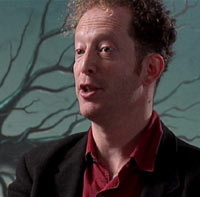
Daniel Glaser of University College London. If you'd prefer to hear rather than read this transcript, listen to the interview in RealAudio or Windows Media, or download the file (1.2MB MP3) for later listening. 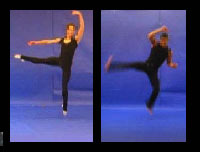
Watch a pair of video clips used in the study. 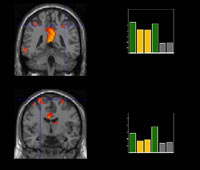
Hear Daniel Glaser describe this graphic, which summarizes the study's results. His caption is available in audio or text. 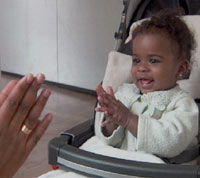
"The brain uses everything it can to try and see the world," Glaser says. "So if you're seeing movement, you've got a whole set of clues that can help you read that, because you yourself can produce it." 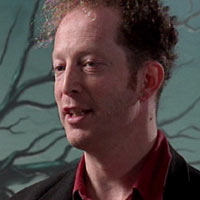
As a visual neuroscientist, Glaser finds mirror neurons a "very fruitful area" in which to work. |
TranscriptRobert Krulwich: Welcome to NOVA scienceNOW, a new series airing on PBS. I'm your host, Robert Krulwich. Now, I know you can't see me now, but if you could, and if I crossed my eyes and then frowned, you could probably imitate that, right? It's second nature, thanks in part to brain cells called "mirror neurons." They're active when we jump up and down. They're active when we wiggle our toes, or make any other motion with our body. But as scientists have found, these same cells are also active when we're just watching someone make those moves. So watching, doing for these cells—exactly the same. One researcher who's looking into this is Daniel Glaser, a cognitive neuroscientist at University College London. He wants to know how human experience shapes the way our brains see the world, and to find out, he's using, of all things, the Royal Ballet and experts in capoeira, a Brazilian martial art. Peter Tyson from NOVA scienceNOW's Web site recently spoke to Dr. Glaser about his study. NOVA scienceNOW: Daniel, thanks for being with us. Now I can't imagine there are many neuroscientists who work with ballet dancers. Why would you use dancers to study mirror neurons? Glaser: What we needed was groups of people who knew how to do something that others didn't. In a sense, the conventional scientific approach would have been to design a weird movement, teach it to people, measure how good they were at doing it and then use those people as subjects. But we thought it would be more interesting and more scientifically precise to take people who already knew how to do a special kind of movement. We chose dance because in dance you've got this vocabulary of movement, these standard moves that all dancers can do. Also you've got a system of professional regulation—you get to be a professional dancer. So we didn't have to worry about measuring people's skills. We had this whole population of experts that we could just tap right into. NOVA scienceNOW: You used ballet and capoeira dancers, is that right? Glaser: That's right. We were looking in this case for two contrasting dance styles, because we wanted to show one group the dance style that they could do, which is their own style, and then also another style. Ballet was an obvious choice because with classical ballet, you can write down the moves, in French usually. And if you write those words down, then all ballet dancers will do exactly the same movement, and they'll understand it. Similarly, in fact, with capoeira, which is a Brazilian martial art. It's made up of simple movements, which can be written down, that have standard names. And, again, all capoeira dancers basically know the same repertoire of moves. NOVA scienceNOW: So you had all these dancers. But none of them was doing any actual dancing in your study? Glaser: Exactly. The task that they were doing was observation only. That's partly because I myself am a visual neuroscientist; I'm interested in how the brain sees the world. But also because the technique that we use to look at people's brains involves a large brain scanner, and in order to get clear images, people have to remain very still. Obviously, in this case, you can't have people doing cartwheels themselves, because you can't do a cartwheel in a brain scanner. We needed them to be lying still. So the task that they were doing was just lying there and looking at these movements. NOVA scienceNOW: So when all this recording and testing and scanning was done, what were you left with? Glaser: The results were interesting. Firstly, we were looking for results in different areas of the brain. Broadly speaking, there are two kinds of brain that we were interested in. Firstly, there's the visual brain. That's the part that normally does seeing, which is actually at the back of your head. And then there's the movement control brain, called premotor cortex, which is around the middle of your head and slightly in front and slightly behind there. Now, what we were interested to see was that when these subjects were lying in the scanner, watching movement, the movement brain is the part of the brain whose activity changes with the kind of movement that they're seeing. So you might think that if they're seeing one dance style or seeing another dance style, it's the visual brain that would see differently. But, no, it's the movement brain that cares whether the style they're seeing is something that they can do or not. NOVA scienceNOW: So the part of the brain that controls movement got more excited by the style the dancers could do than by the style they couldn't do, is that right? Glaser: Exactly. We think that this is a form of resonance if you like, that your own motor control cortex, the bit that would control your own movements, is more excited, it turns out, when you see other people doing moves that you can do. And that's probably because it's resonating with those movements better. It can interpret them in its own terms in a way that it can't when it's seeing a movement style which it doesn't know how to perform. NOVA scienceNOW: So, in a broader sense, why is the mirror neuron system important? What's its purpose in the brain? Glaser: Well, purpose in the brain.... You may know the Just So Stories of Rudyard Kipling, "How the Elephant Got Its Trunk." Discussing purpose always has an evolutionary cast. Why was it beneficial to our ancestors to develop this system? There will always be a degree of speculation involved here. But from the perspective first of all of the visual neuroscientist—that's people like me who are trying to understand how we see—I think it's part of a more general result, which is that the brain uses everything it can to try and see the world. It will use knowledge of all sorts to help it to interpret the world in front of it. So if you're seeing movement, you've got a whole set of clues that can help you read that, because you yourself can produce it. NOVA scienceNOW: But just how important a part of the brain is it? Would you be lost without it? Glaser: Well, that's a very interesting question. Firstly, I'm not aware of any patient data that shows a specific impairment, that is, a specific problem, with the mirror system. It's not that the mirror system is the only way that the brain can see movement; it just gives us an extra special helping hand. Now, in the realm of speculation, some people think that your ability to read other people's movement helps you to understand what they're thinking. The way to understand that is that we move differently when we're happy or when we're sad. And, in fact, we can empathize to some extent with the way people are feeling by reading their movements in a special way. Now, if you speculate, there are some people who find it very difficult to read the emotions of others. Among these are people with autistic spectrum disorders. For people who have difficulty reading emotions, one hypothesis, which has not yet been tested, but one possibility is that they have a problem understanding the movements of others, and this may contribute to or have caused their difficulty in reading the emotions of others. NOVA scienceNOW: So where do you think all this research will ultimately lead? Glaser: Firstly, one thought that often motivates people in this area, although it's not in fact what brings me to work in the morning, but I think it would be nice, is if there were some disorders which we were able to help. Possibilities include disability or spinal injury, right the way through to disorders of emotional cognition, like I said, autism—inability to read the states of others. It's quite possible by understanding these systems better, we'll be able to come up with better therapies, be it surgical interventions or drugs or rehabilitation training, that will benefit from our understanding of how these systems get together. I should emphasize that firstly, I don't work on that, and secondly, I think we're quite far still from this kind of therapeutic work. But certainly it's important to understand a system before you can fix it. NOVA scienceNOW: I see. Interesting. So, it seems like there's a lot of potential in this field. Do you expect to be doing this the rest of your career? Glaser: It's possible that throughout my scientific career mirror neurons will play a role. Remember that for me they're part of a more general case, which is how your expectations and your experiences and your prejudice shape the world that we see. You might think of vision as being a bit of a passive process, as if your eye is open to the world and the photons come off the world and into your eye and fall onto your retina as if it were some glorified camera. But what we're discovering more and more, and in truth the Greeks and the Renaissance scholars also had an understanding of this, is that vision is an active process. Seeing is a process of projecting what you expect out into the world and constantly matching your experience, your prejudice, your expectation with what's out there. For me the mirror neurons are a particular system which embodies this principle, and for me it's a very fruitful area. NOVA scienceNOW: Well, Daniel, thank you again for speaking with us, and best of luck with your future work. Glaser: Okay. It's been a pleasure.
Robert Krulwich: For more on mirror neurons and on Daniel Glaser's work and
much, much, much more, go online to www.pbs.org/nova/sciencenow.
|
“It’s important to understand a system before you can fix it.” |
|||||||||
|
|
|||||||||||
|
© | Created January 2005 |
|||||||||||